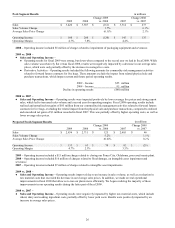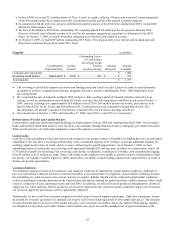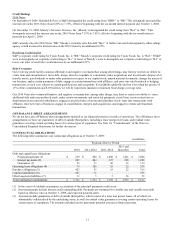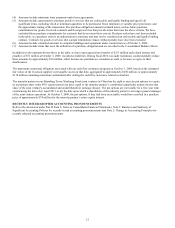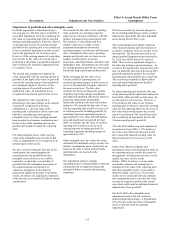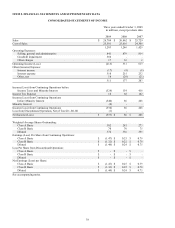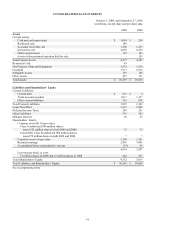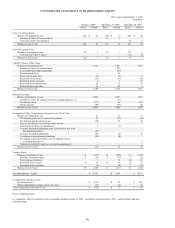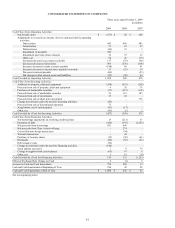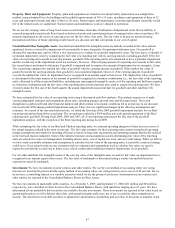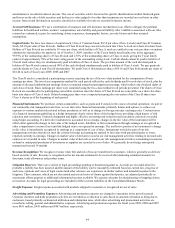Tyson Foods 2009 Annual Report Download - page 36
Download and view the complete annual report
Please find page 36 of the 2009 Tyson Foods annual report below. You can navigate through the pages in the report by either clicking on the pages listed below, or by using the keyword search tool below to find specific information within the annual report.
36
Description
Judgments and Uncertainties
Effect if Actual Results Differ From
Assumptions
Income taxes
We estimate total income tax expense
based on statutory tax rates and tax
planning opportunities available to us in
various jurisdictions in which we earn
income.
Federal income tax includes an estimate
for taxes on earnings of foreign
subsidiaries expected to be remitted to the
United States and be taxable, but not for
earnings considered indefinitely invested
in the foreign subsidiary.
Deferred income taxes are recognized for
the future tax effects of temporary
differences between financial and income
tax reporting using tax rates in effect for
the years in which the differences are
expected to reverse.
Valuation allowances are recorded when it
is likely a tax benefit will not be realized
for a deferred tax asset.
We record unrecognized tax benefit
liabilities for known or anticipated tax
issues based on our analysis of whether,
and the extent to which, additional taxes
will be due.
Changes in tax laws and rates could
affect recorded deferred tax assets and
liabilities in the future.
Changes in projected future earnings
could affect the recorded valuation
allowances in the future.
Our calculations related to income taxes
contain uncertainties due to judgment
used to calculate tax liabilities in the
application of complex tax regulations
across the tax jurisdictions where we
operate.
Our analysis of unrecognized tax
benefits contains uncertainties based on
judgment used to apply the more likely
than not recognition and measurement
thresholds.
We do not believe there is a reasonable
likelihood there will be a material
change in the tax related balances or
valuation allowances. However, due to
the complexity of some of these
uncertainties, the ultimate resolution
may result in a payment that is
materially different from the current
estimate of the tax liabilities.
To the extent we prevail in matters for
which unrecognized tax benefits have
been established, or are required to pay
amounts in excess of our recorded
unrecognized tax benefits, our effective
tax rate in a given financial statement
period could be materially affected. An
unfavorable tax settlement would require
use of our cash and result in an increase
in our effective tax rate in the period of
resolution. A favorable tax settlement
would be recognized as a reduction in
our effective tax rate in the period of
resolution.
ITEM 7A. QUANTITATIVE AND QUALITATIVE DISCLOSURES ABOUT MARKET RISK
MARKET RISK
Market risk relating to our operations results primarily from changes in commodity prices, interest rates and foreign exchange rates,
as well as credit risk concentrations. To address certain of these risks, we enter into various derivative transactions as described
below. If a derivative instrument is accounted for as a hedge, depending on the nature of the hedge, changes in the fair value of the
instrument either will be offset against the change in fair value of the hedged assets, liabilities or firm commitments through earnings,
or be recognized in other comprehensive income (loss) until the hedged item is recognized in earnings. The ineffective portion of an
instrument’s change in fair value is recognized immediately. Additionally, we hold certain positions, primarily in grain and livestock
futures that either do not meet the criteria for hedge accounting or are not designated as hedges. With the exception of normal
purchases and normal sales that are expected to result in physical delivery, we record these positions at fair value, and the unrealized
gains and losses are reported in earnings at each reporting date. Changes in market value of derivatives used in our risk management
activities relating to forward sales contracts are recorded in sales. Changes in market value of derivatives used in our risk
management activities surrounding inventories on hand or anticipated purchases of inventories are recorded in cost of sales.
The sensitivity analyses presented below are the measures of potential losses of fair value resulting from hypothetical changes in
market prices related to commodities. Sensitivity analyses do not consider the actions we may take to mitigate our exposure to
changes, nor do they consider the effects such hypothetical adverse changes may have on overall economic activity. Actual changes
in market prices may differ from hypothetical changes.


